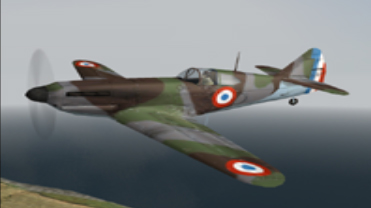D.520

| |
| Dewoitine D.520 | |
| Specifications | |
| Type | Fighter |
| Armament | 1 x 20 mm Cannon, 4 x 7.5 mm Machine Guns |
| Crew | 1 (Pilot) |
| Weight | 2,670kg |
| Top Speed | 530km/h |
| Armored Glass Windscreen | yes |
| Pilot Armor (back/head) | yes |
History
Designed in 1936, the Dewoitine D.520 was the best French-designed fighter of World War II. As the only competitive successor to the Morane-Saulnier 406, the D.520 was faster, maneuverable and blessed with a very good roll rate.
Well armed with a single Hispano type 404 20mm canon firing through the spinner and an additional four 7.5 mm guns in the wings, the little D.520 was armed almost as well as its opponent in the Bf109E. There were some initial problems centered in the cooling system of the early examples but these were quickly rectified before the bulk of combat that they would be thrown into during the German invasion. After the fall of France in 1940, the D.520 went on to serve for the Vichy forces in North Africa, and so fought against both Allied and Axis aircraft.
Game Play
The long-nosed “Dewo” is a potent fighter that does not take kindly to being underestimated and can hold its own well into the later generations of more powerful fighters. Graced with excellent manoeuvrability and a more than decent turn rate, it rolls and dives wonderfully with deft and precise response of controls. On the debit side however are some severely limiting factors: it cannot climb as well as its main adversary the Bf 109-E; it is considerably slower than the Bf 109-E at all altitudes and only just faster than the Bf 110; and it is prone to violent departure if pushed beyond the point of stall. That said, the D.520’s is in its element at 4-6 km altitude where its speed picks up considerably in comparison to how it behaves on the deck. Because of this, the smart D.520 pilot begins his sortie by clearing out the high layers of any particular combat area, at the altitude where his aircraft is the most effective, before hurtling down to join the food fight at lower altitudes.
The D.520 can be utilized equally well for disciplined Boom & Zoom tactics and for “fangs out, hair afire” dogfighting on account of its good diving characteristics and solid turning ability – the Dewo will easily make the careless Messerschmitt driver sweat bullets and can barrel-roll itself out of threatening situations with grace and economy. It does however have lackluster acceleration in level flight and getting slow on the deck is a certain recipe for disaster, especially against an enemy with better power loading such as the Bf 109-F or FW 190. When fighting at a disadvantage against these opponents the D.520 pilot must employ his excellent rate of roll and rate of turn to get out of the enemy plane of manoeuvre, and become intimately familiar with the Rolling Scissors and Lag Roll Attack to have any chance of prevailing.
The most appreciated (and feared) feature of the D.520 is its gun package. Its centerline Hispano 404 20 mm cannon fires a heavy explosive round at high muzzle velocity that strikes hard and true. However, it has a limited allowance of ammunition, requiring the pilot to be a miser and only use the cannon when he is certain to score hits – the 60 rounds carried are easily spent in just a handful of bursts. The four 7,5 mm MAC wing-mounted machineguns are useful enough and carry enough ammo to last through a sortie, but they do require the pilot to “saddle up” at close range behind the target for an extended time. Be sure to set your convergence to anything less than 200 meters, for beyond that range the bullets lose much of their destructive potential.
D.520 pilots tend to be a special bunch, having learned to be effective where their climb rate and top speed is often found inferior to their most frequent opponents. To offset these very material disadvantages, D.520 pilots quickly learn to stack the deck in their favour by climbing to superior altitude, to attack with the advantage of surprise where their cannon fire is all the more telling, and to add wingmen to the equation. The Sierra Hotel pilots fly in winged pairs or larger groups supporting each other with wingman tactics and watching each others tails, using voice communications to leverage yet another advantage against single or unorganized enemy pilots.
| Air Units in Battleground Europe | |
|---|---|
| Fighters and fighter bombers | |
| Bf 109E-1 | Bf 109E-4| Bf 109E-4B |Bf 109F-2 | Bf 109F-4 | Bf 109G-2/R1| Bf 109G-6/U4 | Bf 110C-4 | Bf 110C-4/B | Blenheim IF | Dewoitine D.520 | Fw 190A-3B | Fw 190A-4 | Hawk 75 | Hawk 81 | Hawk 87 | P-40F Kittyhawk Fighter Bomber | | Hurricane Mk I | Hurricane Mk IIb | Hurricane Mk IIc | Hurricane Mk IID | Junkers 87G2 'Stuka' | P-38 'Lightning' | Bell Model 14a / P-400 Airacobra | Model 26 / P-39N Airacobra | Spitfire Mk Ia | Spitfire Mk IIb | Spitfire Mk Vb | Spitfire Mk IXc | |
| Bombers | |
| Blenheim IV | Douglas DB-7 | Havoc Mk.I | A20C Havoc | Heinkel 111 | Junkers Ju 88A4 | Junkers 87 'Stuka' | | |
| Transport | |
| C47 'Skytrain' | Junkers 52 | |